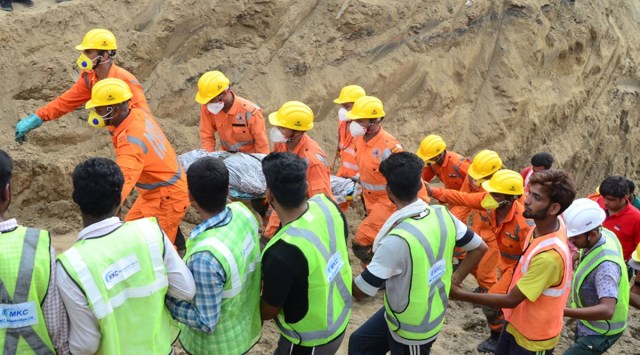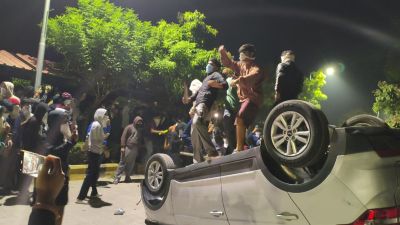45-hour rescue operation ends in tragedy, body extracted from 70-foot pit
The incident took place on the Kapurthala-Kartarpur stretch of the under-construction Delhi-Amritsar-Katra Expressway on August 12
 Three personnel from the NDRF and a civilian extracted at 4 pm on Monday the body of Suresh Yadav, who got trapped in a 70-foot pit on the Kapurthala-Kartarpur stretch of the under-construction Delhi-Amritsar-Katra Expressway on August 12. (Express Photo)
Three personnel from the NDRF and a civilian extracted at 4 pm on Monday the body of Suresh Yadav, who got trapped in a 70-foot pit on the Kapurthala-Kartarpur stretch of the under-construction Delhi-Amritsar-Katra Expressway on August 12. (Express Photo) After a tense rescue operation spanning 45 hours, three personnel from the National Disaster Response Force (NDRF) and a civilian extracted at 4 pm on Monday the body of Suresh Yadav, who got trapped in a 70-foot pit on the Kapurthala-Kartarpur stretch of the under-construction Delhi-Amritsar-Katra Expressway on August 12.
Suresh, 54, was fixing a malfunctioning earth boring machine at the time of the incident. A resident of Jind district in Haryana, he is survived by his wife and three children.
 The expressway project falls under the purview of the NHAI, which had subcontracted the construction to a private contractor. (Express Photo)
The expressway project falls under the purview of the NHAI, which had subcontracted the construction to a private contractor. (Express Photo)
The expressway project falls under the purview of the NHAI, which had subcontracted the construction to a private contractor. The contractor had employed Pawan Kumar to fix the machine that had broken down days ago. The machine was required to bore a 60-foot trench to lay pillars for the expressway.
Pawan said the contractor had promised to pay him Rs 1.20 lakh to fix the machine. Since Suresh was his friend and an expert in fixing such machines, Pawan hired him for Rs 1,000 per day, besides free boarding and lodging. The two friends, who belong to Haryana, had arrived at the site on August 9.
According to Pawan, they both entered the pit, which had a diameter of 4 feet, together. While he managed to exit safely after completing his work, the earth collapsed on Suresh, who was nearly done with his repairs, around 7 pm. At the time of the cave-in, Suresh had an oxygen cylinder but its pipe was later found damaged.
 Suresh, 54, was fixing a malfunctioning earth boring machine at the time of the incident. (Express Photo)
Suresh, 54, was fixing a malfunctioning earth boring machine at the time of the incident. (Express Photo)
Santosh Arya, the NHAI project director, said, “It was an unfortunate incident. Despite best efforts and following all safety norms, Suresh could not be saved. The NHAI will compensate his family. The weight of extracted soil at the site led to the cave-in.”
As soon as he learnt about the incident, the contractor swung into action. When the Jalandhar district administration was informed about the accident, it roped in the NDRF. A team arrived at the spot at 1.15 am on August 13 and immediately started removing the earth with the help of machines provided by the NHAI. Given that it was a muddy pit, the NDRF said, no other method would have worked. Pawan was present at the site throughout the search operation since he was the sole eyewitness and knew Suresh’s exact location.
Despite multiple cave-ins and seepage of water inside the pit during the 45-hour operation, the team spotted “traces” of Suresh around 8.30 pm on August 13. A team member said, “Multiple attempts to reach Suresh were thwarted due to the unsteady terrain and repeated cave-ins.”
Three NDRF personnel and Pawan finally entered the pit around 4 pm on Monday and managed to extract Suresh’s body. His remains have been taken to the civil hospital for a post-mortem.
Talking to The Indian Express, a visibly shaken Pawan said, “Suresh was about to exit the pit when it caved-in. Perhaps if the rescue operation had been shorter, he would have made it out alive. He had an oxygen cylinder with him, but the weight of the collapsed earth must have broken the pipe.”
 Three NDRF personnel and Pawan finally entered the pit around 4 pm on Monday and managed to extract Suresh’s body. (Express Photo)
Three NDRF personnel and Pawan finally entered the pit around 4 pm on Monday and managed to extract Suresh’s body. (Express Photo)
Suresh’s brother Satyabhan said, “My brother was an expert in his field. I don’t know what happened.”
DL Jakhar, the Assistant Commander of the 7th NDRF battalion stationed in Ludhiana, told The Indian Express, “It was a very critical operation. As per our assessment, digging was the only solution. Since it was a pit and not a borewell, we could not use a torch to locate Suresh. The multiple cave-ins and water in the pit delayed the operation. We finally dug a hole that was nearly 15 feet in diameter. We had to take calculated risks since the soil was unstable. In the end, three NDRF personnel and Pawan entered the pit to extract Suresh’s body.”
Jalandhar Additional Deputy Commissioner Jasbir Singh was also present at the spot throughout the rescue operation. Stating that a bridge is being built at the spot, NHAI officials said the machine was stuck at a depth of 20 metres. “We tried to pull it mechanically, but all attempts failed. So the contractor hired these two experts. Suresh had come out of the pit once on August 12, before going inside,” said a senior NHAI officer, adding that Pawan and Suresh had been fixing such machines for nearly 25 years across India without any problems.
The officer added, “Suresh was carrying safety equipment, including oxygen cylinders, but it stood no chance against the weight of the soil that caved-in on him.”







